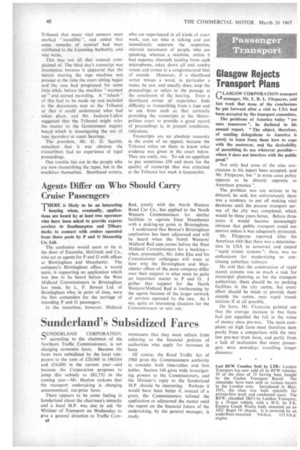Glasgow Rejects Transport Plans
Page 42

If you've noticed an error in this article please click here to report it so we can fix it.
GLASC OW CORPORATION transport manager, Mr. E. R. L. Fitzpayne, said last week that none of the conclusions he put forward after a visit to USA had been accepted by the transport committee.
The problems of America today "are ours tomorrow ", he declared in his annual report. "The object, therefore, of sending delegations to America is surely to learn from them how to cope with the motorcar, and the desirability of permitting its use wherever possible— where it does not interfere with the public good."
Not only had none of the nine conclusions in his report been accepted, said Mr. Fitzpayne, but "in some cases policy appears to be directly opposite to American practice ".
The problem was too serious to be delayed, he said, but unfortunately there was a tendency to put off making vital decisions until the present transport survey of the city was completed, which would be three years hence. Before three years it would become increasingly obvious that public transport could not survive unless it was adequately protected.
Mr. Fitzpayne reported after his American visit that there was a determination in USA to construct and extend "rapid transit systems "; there was no enthusiasm for modernizing or continuing suburban railways.
He said that the construction of rapid transit systems was as much a task for municipal planning as for the transport authorities; there should be no parking facilities in the city centre, but every effort should be made to provide them outside the centre, near rapid transit stations if at all possible.
On fares, Mr. Fitzpayne pointed out that the average increase in bus fares had just equalled the fall in the value of money since pre-war. The main complaint on high fares must therefore stem partly from a comparison with the very low pre-war tram fares, and partly from a lack of realization that many passengers were nowadays travelling longer distancei
Last RFW Coaches Sold by LTB: London Transport has now sold all its RFW vehicles, 10 of the class of 15 having been bought by the Ceylon Transport Board: The remainder have been sold to various buyers in the London area. Introduced in May, 1951, the class was built specially for private-hire work and conducted tours. The RFW, classified 3RF3 by London Transport, is a 39-seat vehicle, with a 30 ft. by 8 ft. Eastern Coach Works body mounted on an AEC Regal IV chassis. It is powered by an
underfloor-mounted 9.6-litre. 115 b.h.p. engine.




























































































































